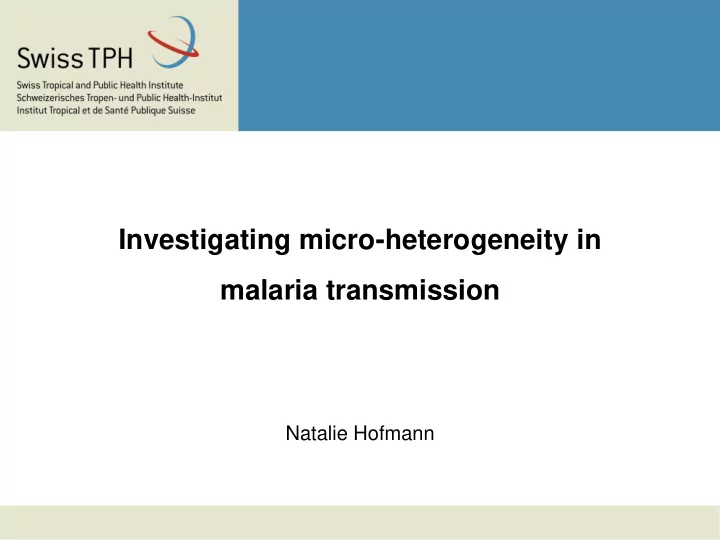

Investigating micro-heterogeneity in malaria transmission Natalie Hofmann
Surrogate markers of transmission X-sectional Longitudinal • Prevalence • molecular force of infection (incidence of new infections • MOI (multiplicity of infection) observed in blood) • % single clone infections • … • Allelic diversity • … P. vivax P. falciparum mol FOI mol FOB New infections from All new infections • from mosquito mosquito bites • relapsing hypnozoites bites 2
Assessing mol FOI/ mol FOB in natural infections Antimalarial Parasite Positivity (qPCR) Clonal positivity (genotyping PCR) molecular Force of Infection ( mol FOI) Measure of individual exposure! 3
Albinama study cohort Child 1 East Sepik Province, PNG, 2009/10 504 children, 5-10 years Child 2 P. vivax relapse 2 treatment arms: CQ d1-3 / AL d15-18 / PQ d1-28, 0.5mg/kg CQ d1-3 / AL d15-18 / Placebo d1-28 Child 3 2-/4-weekly ACD for 9 months PCD implemented in villages Molecular detection and mol FOI / mol FOB high-resolution genotyping: ( Pf-msp2, Pv-msp1F3) 4
Albinama study - geography N=99 N=119 N=70 N=93 N=31 N=54 3 km 5
Markers of exposure by village mol FOI Prevalence % single clone MOI ( P.v. – PQ arm) p<0.001 p=0.031 p<0.001 p=0.157 P. falciparum p<0.001 p=0.008 p=0.100 p<0.001 P. vivax p- values by Chi 2 test, Fisher’s exact test and ANOVA 6
Correlation of surrogate markers for exposure Prevalence MOI % single-clone r = 0.99 r = 0.53 r = - 0.37 P. falciparum mol FOI mol FOI mol FOI r = 0.72 r = 0.59 r = - 0.36 P. vivax mol FOB (PQ arm) mol FOB (PQ arm) mol FOB (PQ arm) 7 r – Pearson’s correlation coefficient
Spatial (micro-) heterogeneity in exposure P. falciparum mol FOI Individual mol FOI/ mol FOB (new inf/pyr) 0 – 23 Pv PQ P. vivax mol FOB 0 – 36 Pv Placebo 0 – 18 Pf Overall 8
Other predictors of exposure Multivariate regression of total mol FOI per child Mean mol FOI [CI 95 ] P. falciparum P. vivax (new infections/pyr) IRR p -value IRR p -value Pv Placebo 5.3 [4.9-5.8] PQ treament ns 0.2 <0.001 Pv PQ 1.6 [1.4-1.8] Age ns 0.9 0.02 Pf Overall 1.4 [1.2-1.6] Village Amahup 0.6 0.3 Balanga 1.8 1.4 <0.001 <0.001 Balif 0.8 0.7 How do differences in Bolumita 4.8 2.3 exposure translate Numangu 2.4 0.7 Enrolment e.g. to risk for 1.7 0.003 1.4 0.01 status episodes? Negative binomial regression also adjusted for sex, average bednet use and distance to health center. ns: not significant 9
mol FOI as predictor for clinical episodes? Cohort Eask Sepik, children 1-4 years mol FOI/ mol FOB Episode incidence P. falciparum Mueller et al., PNAS (2012) Aquisition of new clones determines risk for clinial episodes P. vivax Koepfli et al., Plos NTD (2013) High number of new infections drives rapid aquisition of clinical immunity 10
mol FOI as predictor for clinical episodes? Cohort Eask Sepik, children 5-10 years mol FOI/ mol FOB Episode incidence P. falciparum P. vivax 11
mol FOI as predictor for clinical episodes? Cohort Eask Sepik, children 5-10 years Highest episode incidence was highest in villages of high mol FOI/ mol FOB No association of individual exposure ( mol FOB) with odds of clinical P. vivax episode Age was single significant predictor for odds of clinical P. vivax episode (OR = 0.73, p =0.02) Association of individual exposure ( mol FOI) with odds of clinical P. falciparum episode (OR = 0.85, p =0.01) Other predictors for odds of P. falciparum clinical episode Pf density (qPCR) OR = 1.42, p <0.01 Pv positivity (qPCR) OR = 0.29, p <0.01 Parameter estimates from binomial GEE with logit link 12
Summary Genotyping and tracking of individual parasite clones in cohort studies allows assessing detailed patterns of exposure on individual level ( mol FOI/ mol FOB) High heterogeneity in exposure for both Plasmodium species over very small spatial scales (<3km) in a cohort of 5-10 year old children from Papua New Guinea Increase understanding of effects of exposure on various outcomes Application for planning of control measures, evaluation of vaccine trials, drug trials, … 13
Acknowledgements Ingrid Felger Leanne Robinson Ivo Mueller Rahel Wampfler Peter Siba Stephan Karl Tom Smith Inoni Betuela Connie Li Wai Suen Mariah Silkey The field team Andreea Waltmann Amanda Ross The Goroka lab team The study participants and their Financial support families Swiss National Science Foundation Brazilian-Swiss Joint Research Partnership ICEMR TRANSEPI Bill and Melinda Gates Foundation 14
Recommend
More recommend